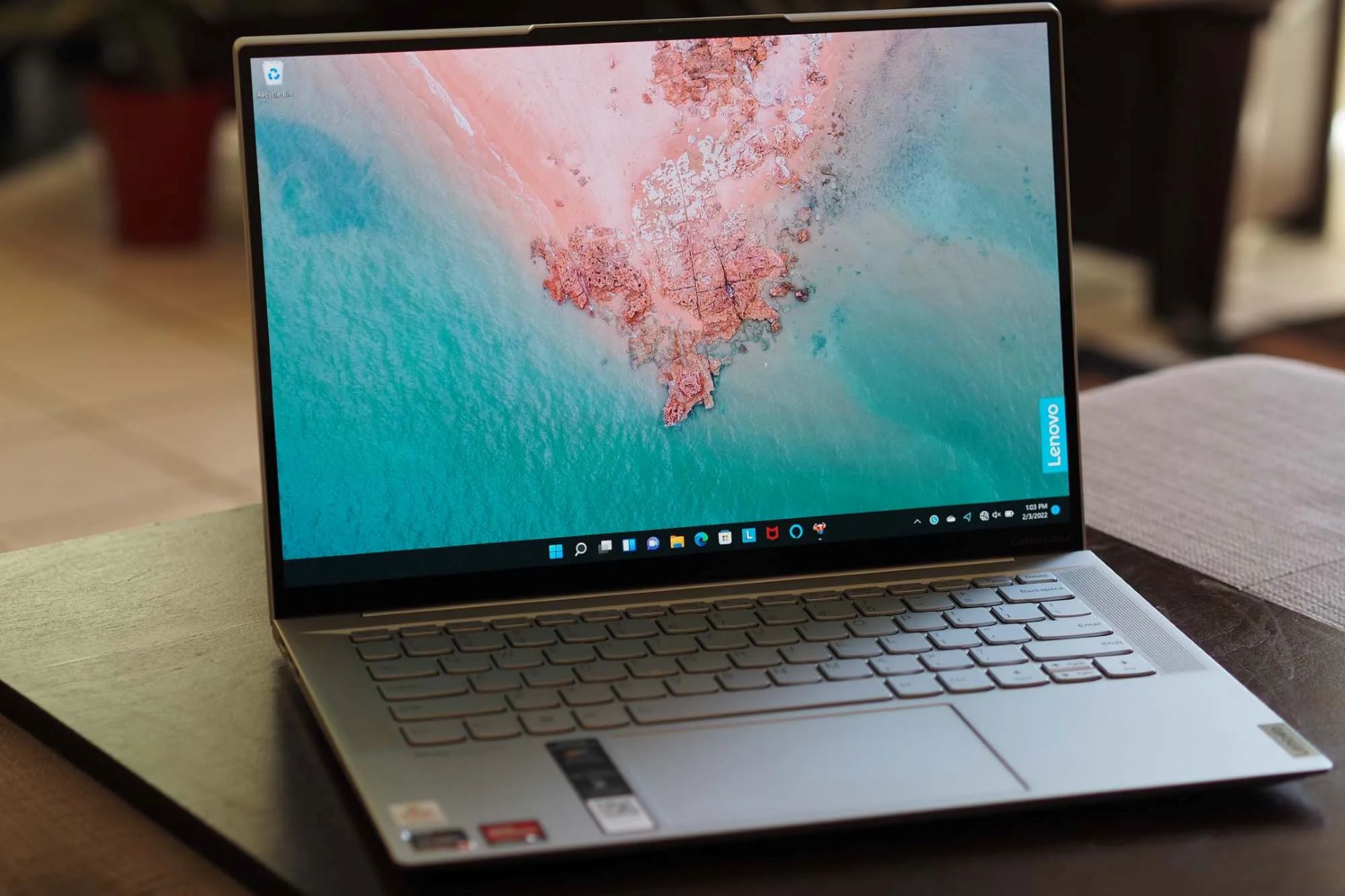Introduction
Connecting your Lenovo laptop to a Wi-Fi network allows you to take advantage of the convenience and mobility that wireless internet offers. Whether you need to work on important assignments, stream your favorite shows, or simply browse the web, having a stable and reliable Wi-Fi connection is essential. In this guide, we will walk you through the steps to connect your Lenovo laptop to a Wi-Fi network effortlessly.
Before we dive into the steps, it’s important to ensure that your laptop has built-in Wi-Fi capabilities. Most Lenovo laptops come equipped with Wi-Fi functionality, but it’s helpful to double-check if yours has this feature. Look for the Wi-Fi symbol on your keyboard or the wireless icon in the system tray of your laptop’s desktop.
Once you’ve confirmed that your laptop has Wi-Fi capabilities, you’re ready to connect to a Wi-Fi network. This process involves enabling Wi-Fi on your laptop, identifying and connecting to an available network, and entering the password if required. We’ll also provide troubleshooting tips for common Wi-Fi connection issues to help you in case you encounter any problems.
By the end of this guide, you’ll be equipped with the knowledge and confidence to connect your Lenovo laptop to a Wi-Fi network effortlessly. So, let’s get started with the first step: enabling Wi-Fi on your Lenovo laptop.
Step 1: Enable Wi-Fi on your Lenovo laptop
Before you can connect to a Wi-Fi network, you need to make sure that Wi-Fi is enabled on your Lenovo laptop. Follow these simple steps to ensure that your laptop’s Wi-Fi functionality is turned on:
- Locate the “Fn” key on your Lenovo laptop’s keyboard. It is usually located at the bottom left corner and is labeled as “Fn”.
- Look for the Wi-Fi symbol on your keyboard. It is typically represented by an antenna-like icon or a series of curved lines radiating outwards.
- Press and hold the “Fn” key and simultaneously press the key with the Wi-Fi symbol. This key is usually labeled with “F3” or “F12” but may vary depending on your laptop model.
- Release both keys after pressing them. Your laptop’s Wi-Fi should now be enabled.
Once you have enabled Wi-Fi on your Lenovo laptop, you will be able to see the available Wi-Fi networks in your area. You can proceed to the next step to identify and connect to the network of your choice.
It’s worth mentioning that some Lenovo laptops may have a physical Wi-Fi switch or button on the side or front of the device. If your laptop has this switch, ensure that it is in the “on” position to enable Wi-Fi connectivity.
Note: If you’re using an external Wi-Fi adapter on your Lenovo laptop, make sure it is properly connected and configured before attempting to enable Wi-Fi. Refer to the adapter’s user manual or the manufacturer’s website for specific instructions on how to enable Wi-Fi.
Enabling Wi-Fi on your Lenovo laptop is the first step towards connecting to a Wi-Fi network. Once you have successfully enabled Wi-Fi, we can move on to the next step: identifying and connecting to an available Wi-Fi network.
Step 2: Identify and connect to the available Wi-Fi network
After enabling Wi-Fi on your Lenovo laptop, it’s time to identify and connect to an available Wi-Fi network. Follow these steps:
- Click on the Wi-Fi icon located in the system tray on the bottom right corner of your laptop’s desktop. The icon resembles a series of curved lines or the outline of a signal tower.
- A list of available Wi-Fi networks will appear. Look for the network name (also known as the SSID) of the Wi-Fi network you want to connect to. The network names are usually displayed in a dropdown menu.
- Click on the network name to select it. If the network you want to connect to is not displayed, click on the “Refresh” or “Scan for Networks” option to search for available networks again.
- Once you have selected the desired network, click on the “Connect” button. Your laptop will attempt to establish a connection with the Wi-Fi network.
- Wait for a few moments while your laptop connects to the network. You might see a loading or connecting icon during this process.
- If the connection is successful, your Lenovo laptop will display a message indicating that you are now connected to the Wi-Fi network.
Congratulations! You have successfully identified and connected to an available Wi-Fi network on your Lenovo laptop. However, please note that some Wi-Fi networks might require additional steps, such as entering a password or accepting terms and conditions, before you can establish a connection. If prompted, follow the on-screen instructions to complete the connection process.
It’s important to ensure that the Wi-Fi network you’re connecting to is secure and trustworthy. Avoid connecting to unknown or unsecured networks to protect your personal information and prevent potential security risks.
Now that your Lenovo laptop is connected to a Wi-Fi network, you can enjoy the benefits of wireless internet connectivity. In the next step, we will discuss how to enter the Wi-Fi password, if required, to establish a secure connection.
Step 3: Enter the Wi-Fi password, if required
When connecting to a secured Wi-Fi network, you will need to enter the Wi-Fi password to establish a secure connection. Follow these steps to enter the Wi-Fi password on your Lenovo laptop:
- After selecting the Wi-Fi network you want to connect to, your laptop may prompt you to enter the password. This typically happens for secured networks that require authentication.
- Click on the network name and a password input field will appear.
- Type in the Wi-Fi password carefully. Take note that passwords are case-sensitive, so ensure that you correctly capitalize any required letters.
- Double-check the password for accuracy to avoid errors.
- Click on the “Connect” or “Join” button to proceed.
- Your Lenovo laptop will now attempt to establish a connection with the Wi-Fi network using the provided password.
- If the password is correct, your laptop will connect to the network. You will receive a confirmation message stating that you are now connected to the Wi-Fi network.
If you entered an incorrect password or are having trouble connecting, double-check the password for accuracy. If you are uncertain about the password, try contacting the network administrator or the owner of the Wi-Fi network for assistance.
Remember to always be cautious when entering Wi-Fi passwords, especially when connecting to public Wi-Fi networks. Use trustworthy networks and avoid entering sensitive information on unsecured or unfamiliar networks.
Now that you have successfully entered the Wi-Fi password, if prompted, your Lenovo laptop is securely connected to the Wi-Fi network. In case you encounter any issues with the Wi-Fi connection, we will cover some troubleshooting tips in the next step.
Step 4: Troubleshooting common Wi-Fi connection issues
While connecting to a Wi-Fi network on your Lenovo laptop is usually a smooth process, there may be times when you encounter issues. Here are some common Wi-Fi connection issues and troubleshooting tips to help you resolve them:
- No available networks: If you are unable to see any available Wi-Fi networks, check if the Wi-Fi switch on your laptop is turned on. Additionally, make sure that you’re within range of a Wi-Fi network and that the network you’re trying to connect to is operational.
- Weak Wi-Fi signal: If the Wi-Fi signal is weak, try moving closer to the router or access point. You can also adjust the position of the router’s antennas or consider using a Wi-Fi range extender to improve the signal strength.
- Wrong password: Double-check the Wi-Fi password you entered. Passwords are case-sensitive, so ensure that you’ve entered uppercase and lowercase letters correctly. If you’re uncertain about the password, contact the network administrator or check the router’s documentation for the correct password.
- Interference: Wi-Fi signals can be affected by interference from other electronic devices or even physical obstacles. Keep your laptop away from devices that emit electromagnetic waves, such as cordless phones, microwave ovens, and Bluetooth devices. Additionally, ensure that there are no obstacles like walls or large objects blocking the Wi-Fi signal.
- Resetting the router: If you’re unable to connect to a specific Wi-Fi network, try power cycling the router. Simply unplug the router from the power source, wait a few seconds, and then plug it back in. Wait for the router to fully restart and attempt to connect again.
- Updating Wi-Fi drivers: Outdated or incompatible Wi-Fi drivers can cause connection issues. Visit Lenovo’s support website or the manufacturer’s website to download and install the latest Wi-Fi drivers for your laptop’s model.
- Restarting your laptop: Sometimes, restarting your laptop can resolve temporary software glitches or conflicts. Try restarting your Lenovo laptop and then attempt to connect to the Wi-Fi network again.
By following these troubleshooting tips, you should be able to resolve common Wi-Fi connection issues and establish a stable and reliable connection on your Lenovo laptop.
Now that you’re equipped with troubleshooting strategies, you should have no trouble resolving any Wi-Fi connection issues that may arise. In the next section, we will conclude this guide with a summary of the steps you’ve learned.
Conclusion
Connecting your Lenovo laptop to a Wi-Fi network is a simple process that allows you to enjoy wireless internet connectivity. In this guide, we walked through the steps to enable Wi-Fi on your Lenovo laptop, identify and connect to an available Wi-Fi network, enter the Wi-Fi password if required, and troubleshoot common connection issues.
Enabling Wi-Fi on your Lenovo laptop is the first step towards connecting to a Wi-Fi network. By following the instructions to locate and activate the Wi-Fi functionality, you ensure that your laptop is ready to connect wirelessly.
With Wi-Fi enabled, you can easily identify and connect to an available network. By selecting the network name from the list of available networks and clicking connect, you establish a connection to enjoy wireless internet access.
In the event that the Wi-Fi network you want to connect to is secured, you will need to enter the Wi-Fi password to establish a secure connection. By carefully typing the password and double-checking for accuracy, you ensure a successful connection to the network.
If you encounter any issues during the connection process, we provided troubleshooting tips to help you resolve common Wi-Fi connection issues. By following these tips, you can overcome challenges such as no available networks, weak Wi-Fi signal, wrong password entry, interference, router reset, updating drivers, and restarting your laptop.
Remember to always prioritize security when connecting to Wi-Fi networks, especially when using public networks. Avoid connecting to unknown or unsecured networks to protect your personal information and prevent potential security risks.
By following the steps outlined in this guide, you should now be confident in connecting your Lenovo laptop to a Wi-Fi network. Enjoy the freedom and convenience of wireless internet connectivity wherever you go!

























